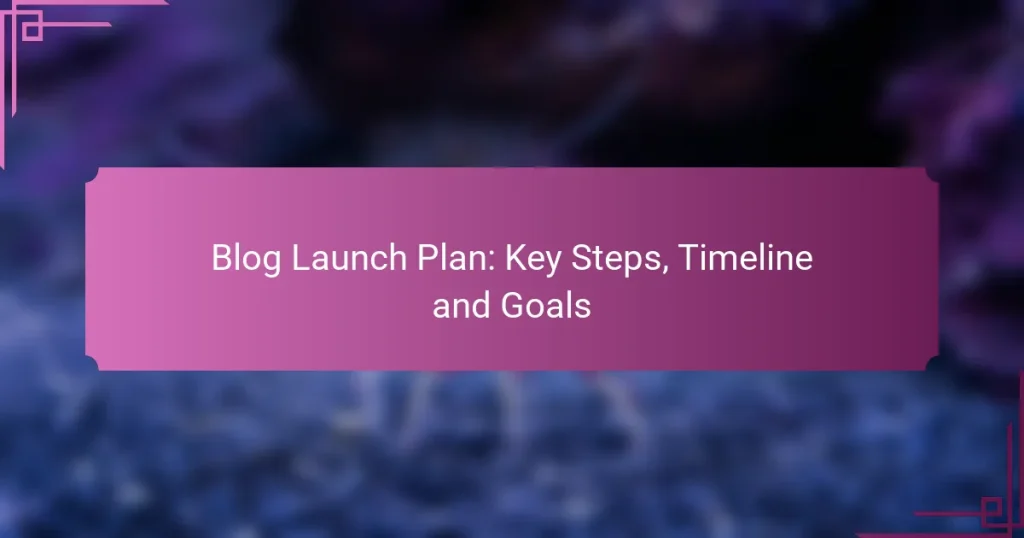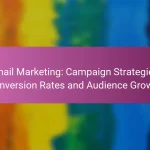Launching a successful blog requires a well-structured plan that encompasses critical steps for defining your niche, positioning your content, and promoting your brand effectively. With a timeline that typically ranges from several weeks to a few months, careful preparation is key to ensuring all elements are ready for a smooth launch. Establishing clear, measurable goals will guide your content strategy and help you track your progress towards achieving your vision.

What are the key steps in a blog launch plan?
A successful blog launch plan involves several critical steps that ensure your blog is well-defined, strategically positioned, and effectively promoted. By following these key steps, you can create a blog that attracts and retains readers while achieving your goals.
Define your niche
Defining your niche is essential for targeting the right audience and establishing your blog’s identity. Consider your interests, expertise, and the needs of potential readers to choose a specific area of focus.
Research existing blogs in your chosen niche to identify gaps and opportunities. Aim for a niche that balances personal passion with audience demand to maximize engagement.
Create a content strategy
A content strategy outlines the types of posts you will publish, the frequency of updates, and the overall tone of your writing. Start by brainstorming topics that resonate with your audience and align with your niche.
Establish a content calendar to plan and schedule your posts. This helps maintain consistency and keeps your audience engaged. Aim for a mix of formats, such as how-to guides, listicles, and opinion pieces.
Set up your blog platform
Selecting the right blog platform is crucial for ease of use and functionality. Popular options include WordPress, Blogger, and Wix, each offering various features and customization options.
Consider factors such as hosting costs, design flexibility, and user support when choosing a platform. Ensure it can accommodate your future growth and any specific needs, such as e-commerce capabilities or SEO tools.
Design your blog layout
Your blog’s layout should be visually appealing and user-friendly. Choose a clean design that enhances readability and navigation, making it easy for visitors to find content.
Utilize themes or templates that reflect your brand’s personality. Pay attention to elements like color schemes, font choices, and image quality to create a cohesive look.
Develop a promotional plan
A promotional plan is vital for driving traffic to your blog. Utilize social media platforms, email marketing, and collaborations with other bloggers to reach a wider audience.
Consider creating shareable content, such as infographics or videos, to enhance your promotional efforts. Regularly analyze your promotional strategies to determine what works best and adjust accordingly.

What is the ideal timeline for launching a blog?
The ideal timeline for launching a blog typically spans several weeks to a few months, depending on your preparation and goals. A structured approach helps ensure that all necessary elements are in place for a successful launch.
Pre-launch activities timeline
Pre-launch activities should start at least 4-8 weeks before your intended launch date. Key tasks include defining your blog’s niche, setting up your website, and creating initial content. This phase is crucial for establishing a strong foundation.
During this time, focus on building your brand identity, including choosing a domain name and designing your site. Additionally, consider creating social media profiles to begin engaging with your target audience early.
Launch day checklist
Your launch day checklist should include finalizing your website, publishing your first few blog posts, and testing all functionalities. Ensure that your site is mobile-friendly and loads quickly, as user experience is vital.
On launch day, promote your blog through social media, email newsletters, and any other channels you’ve established. Engaging with your audience immediately can help generate initial traffic and feedback.
Post-launch evaluation period
The post-launch evaluation period typically lasts 4-6 weeks after your blog goes live. During this time, monitor key performance indicators like traffic, engagement, and user feedback to assess your blog’s success.
Use analytics tools to track visitor behavior and identify areas for improvement. This evaluation will inform your content strategy and help you refine your approach moving forward.

What goals should you set for your blog?
Setting clear goals for your blog is essential for measuring success and guiding your content strategy. Focus on specific, measurable outcomes that align with your overall vision, such as traffic, engagement, and monetization.
Traffic goals
Traffic goals define the number of visitors you aim to attract to your blog over a specific period. A common target for new blogs is to reach 1,000 to 5,000 monthly visitors within the first six months. This can be achieved through effective SEO practices, social media promotion, and guest blogging.
Consider breaking down your traffic goals into weekly or monthly targets to monitor progress. Analyze which sources drive the most traffic and adjust your strategies accordingly to maximize reach.
Engagement metrics
Engagement metrics measure how visitors interact with your content, including comments, shares, and time spent on the page. Aim for a low bounce rate (ideally below 50%) and a high average session duration (several minutes) to indicate that readers find your content valuable.
To enhance engagement, encourage comments and feedback by asking questions at the end of your posts. Use tools like Google Analytics to track these metrics and refine your content strategy based on user behavior.
Monetization targets
Monetization targets outline your financial goals for the blog, such as earning a specific amount through ads, affiliate marketing, or sponsored posts. New bloggers might aim for $100 to $500 per month within the first year, gradually increasing as traffic and engagement grow.
Set realistic milestones for each monetization method and diversify income streams to reduce risk. Regularly review your performance against these targets to adapt your strategies and maximize revenue potential.

What tools can assist in launching a blog?
Several tools can significantly streamline the blog launch process, enhancing functionality, design, and performance tracking. Key tools like WordPress, Canva, and Google Analytics provide essential features that cater to different aspects of blogging, from content creation to audience analysis.
WordPress for blogging
WordPress is a leading platform for creating and managing blogs, known for its user-friendly interface and extensive customization options. It offers a variety of themes and plugins that can help you tailor your blog’s appearance and functionality to meet your specific needs.
When using WordPress, consider whether you want to use the hosted version (WordPress.com) or the self-hosted version (WordPress.org). The self-hosted option provides greater flexibility and control over your content, while the hosted version is simpler for beginners.
Canva for design
Canva is a graphic design tool that simplifies the creation of visually appealing images for your blog. It offers a wide range of templates for blog headers, social media posts, and infographics, making it easy to maintain a consistent visual identity.
Utilize Canva’s drag-and-drop interface to customize designs quickly. Keep in mind that high-quality images can enhance user engagement, so aim for professional-looking graphics that align with your blog’s theme and audience preferences.
Google Analytics for tracking
Google Analytics is an essential tool for tracking your blog’s performance and understanding your audience. It provides insights into visitor behavior, traffic sources, and engagement metrics, allowing you to make data-driven decisions to improve your content strategy.
To get started, set up a Google Analytics account and integrate it with your blog. Regularly review key metrics such as page views, bounce rates, and user demographics to identify trends and areas for improvement. This information can guide your content creation and marketing efforts effectively.

What are the common mistakes to avoid when launching a blog?
Common mistakes when launching a blog can hinder its success and growth. Avoiding these pitfalls is crucial for establishing a strong online presence and engaging your audience effectively.
Neglecting SEO
Neglecting SEO can severely limit your blog’s visibility in search engines. Without proper optimization, your content may remain undiscovered by potential readers. Focus on keyword research, on-page SEO elements, and building backlinks to enhance your blog’s search engine ranking.
Consider using tools like Google Keyword Planner or SEMrush to identify relevant keywords. Aim to incorporate these keywords naturally into your titles, headings, and content. Regularly updating your blog with fresh content can also improve your SEO performance over time.
Inconsistent posting schedule
Inconsistent posting can lead to a disengaged audience and reduced traffic. Establishing a regular posting schedule helps build anticipation among readers and encourages them to return for new content. Aim for a frequency that is manageable, whether that’s weekly, bi-weekly, or monthly.
To maintain consistency, create a content calendar that outlines your topics and posting dates. This can help you stay organized and ensure you have a steady flow of content. Remember, quality is just as important as quantity; prioritize producing valuable posts over simply meeting a deadline.


